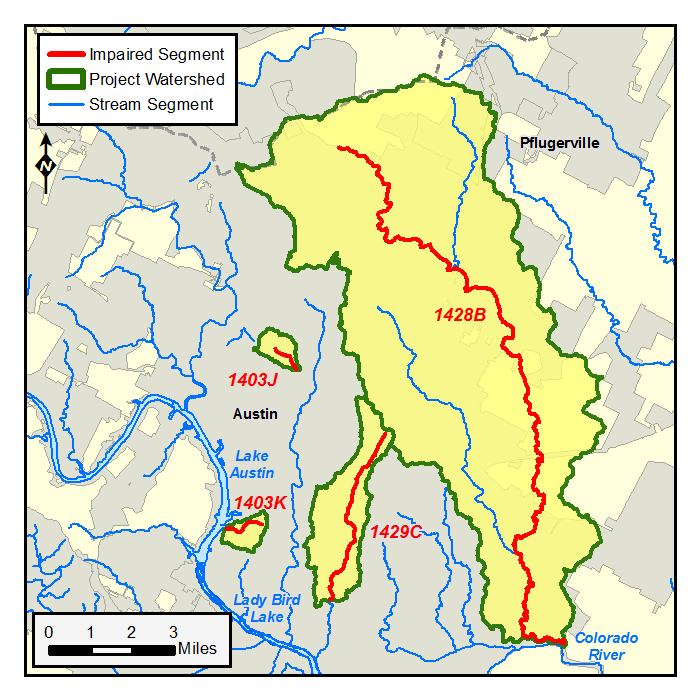Austin Area Watersheds
County: Travis
Parameter: Bacteria
River Basin: Colorado
Segments: 1403J, 1403K, 1428B, 1429C
On this page:
- Background and Goal
- Watershed Description
- Get Involved
- Status and Activities
- Approved I-Plan and Adopted TMDLs
- Contact the TMDL Program Team
Background and Goal
High concentrations of bacteria are often found in four streams in the Austin metropolitan area — Waller and Walnut Creeks, Spicewood Tributary to Shoal Creek, and Taylor Slough South. High concentrations of bacteria may indicate a health risk to people who swim or wade in the creeks—activities called “contact recreation” in the state’s standards for water quality.
The goal of the project is to reduce bacteria levels to protect people who swim or wade in the creeks. The City of Austin provides information about the watersheds on its ATX: Find Your Watershed map-based viewer. Click on the watershed of interest to you to see its most recent environmental summaries and scores.
Watershed Description
Waller Creek (1429C), with a drainage area of six square miles upstream of the Waller Creek Tunnel, is strongly influenced by runoff from the immediate downtown area and the University of Texas (UT) campus. Austin Water Utility maintains a wastewater collection system in the Waller Creek watershed. Although it does not discharge to Waller Creek, wastewater collector pipes run the length of the creek, crossing it many times.
Walnut Creek (1428B) flows from northern Austin to the Colorado River. It flows naturally most of the time and drains about 43 square miles. Development in the upper section of the watershed has been faster and denser than in the lower section.
Spicewood Tributary (1403J) is a small stream that in northwest Austin that flows into Shoal Creek. It is heavily influenced by stormwater runoff from Spicewood Springs Road and other adjacent neighborhood streets, and possibly by the single-family residences along the creek. Wastewater pipes in the collection system run the length of the tributary. Spicewood Spring, the source of the tributary, is at a higher elevation and is not affected by water quality in the stream.
Taylor Slough South (1403K) is about a mile long, with a watershed of about half a mile. It flows through the central-west part of the city and into Lake Austin. Multiple wastewater pipes parallel and cross the creek immediately upstream of Reed Park, which maintains a swimming pool and restrooms. Some sections of the creek, which lies entirely within the Edwards Aquifer recharge zone, become dry for part of the year.
 See project photo galleries.
See project photo galleries.
Get Involved
Throughout this project, all interested stakeholders and communities that use or affect the four Austin streams in the TMDL have been engaged in developing the strategy to improve water quality. The UT School of Law Center for Public Policy Dispute Resolution coordinated public involvement development of the original I-Plan, and also coordinated the update to the Austin Watersheds I-Plan, which extends implementation activities for an additional five years, through 2027. TCEQ coordinates annual meetings about implementation status.
For more information about the I-Plan Update, visit the Austin Streams I-Plan Update webpage.
Learn about what it means to participate in TMDL projects.
Status and Activities
The City of Austin has added a new feature, the City of Creeks Learning Series  , to their YouTube channel. The video series aims to help residents understand how streams function, how they can affect water quality, and how the City manages the quality of its streams. Topics include Proactive Solutions to Project Our Watersheds, Stormwater Control Measures, Challenges of an Ever-Growing City, and Ecological Thresholds.
, to their YouTube channel. The video series aims to help residents understand how streams function, how they can affect water quality, and how the City manages the quality of its streams. Topics include Proactive Solutions to Project Our Watersheds, Stormwater Control Measures, Challenges of an Ever-Growing City, and Ecological Thresholds.
Status
Stakeholders met between June 2021 and August 2022 to develop an update to their original I-Plan. They submitted their final draft of the Updated I-Plan to TCEQ on August 24, 2022. See information about the stakeholder group, including meeting announcements and records, on the Austin Area Watersheds I-Plan Update webpage.
Status updates will resume in 2023. See stakeholder reports of progress on their original January 2015 I-Plan below.
- Year 8 status
- October 2023 Status (year 8)
- Year 5 Status
- August 2019 Status (Years 3 and 4)
- October 2017 Status (Years 1 and 2)
 See project photo galleries.
See project photo galleries.
Approved I-Plan and Adopted TMDLs
Updated Austin Streams I-Plan
Stakeholders in the Austin Streams I-Plan updated the current I-Plan to extend their efforts for an additional five years, 2023 through 2027. See information about the stakeholder group, including meeting announcements and records, on the Austin Area Watersheds I-Plan Update webpage.
Approved I-Plan
On January 21, 2015, the Commission approved this I-Plan. Community stakeholders created the plan.
Adopted TMDLs
On January 21, 2015, the Commission adopted these TMDLs. Community stakeholders advised TCEQ on their development. EPA approved the TMDLs on March 18, 2015, at which time they became part of the state’s Water Quality Management Plan.
-
Five Total Maximum Daily Loads for Indicator Bacteria in Four Austin Streams
Segments: 1403J, 1403K, 1428B, and 1429C; Assessment Units: 1403J_01, 1403K_01, 1428B_05, 1429C_02, and 1429C_03 - Response to Public Comment on the TMDLs
April 2015 Update to the TMDLs
At request of the Austin Streams stakeholder group, TCEQ added four TMDLs for Austin Streams via the April 2015 Water Quality Management Plan Update. The TMDLs, which were discussed in the original TMDL report adopted by the Commission, are for assessment units that are of concern, but which are not identified as impaired on the 303(d) List.
-
Attachment 1. Inclusion of Four Assessment Units to Five Total Maximum Daily Loads
Segments: 1428B; Assessment Units: 1428B_01, 1428B_02, 1428B_03, and1428B_04
Contact the TMDL Program Team
Please email tmdl@tceq.texas.gov and mention the Austin Area Watersheds project. Or call us at 512-239-6682.






 Back to top
Back to top